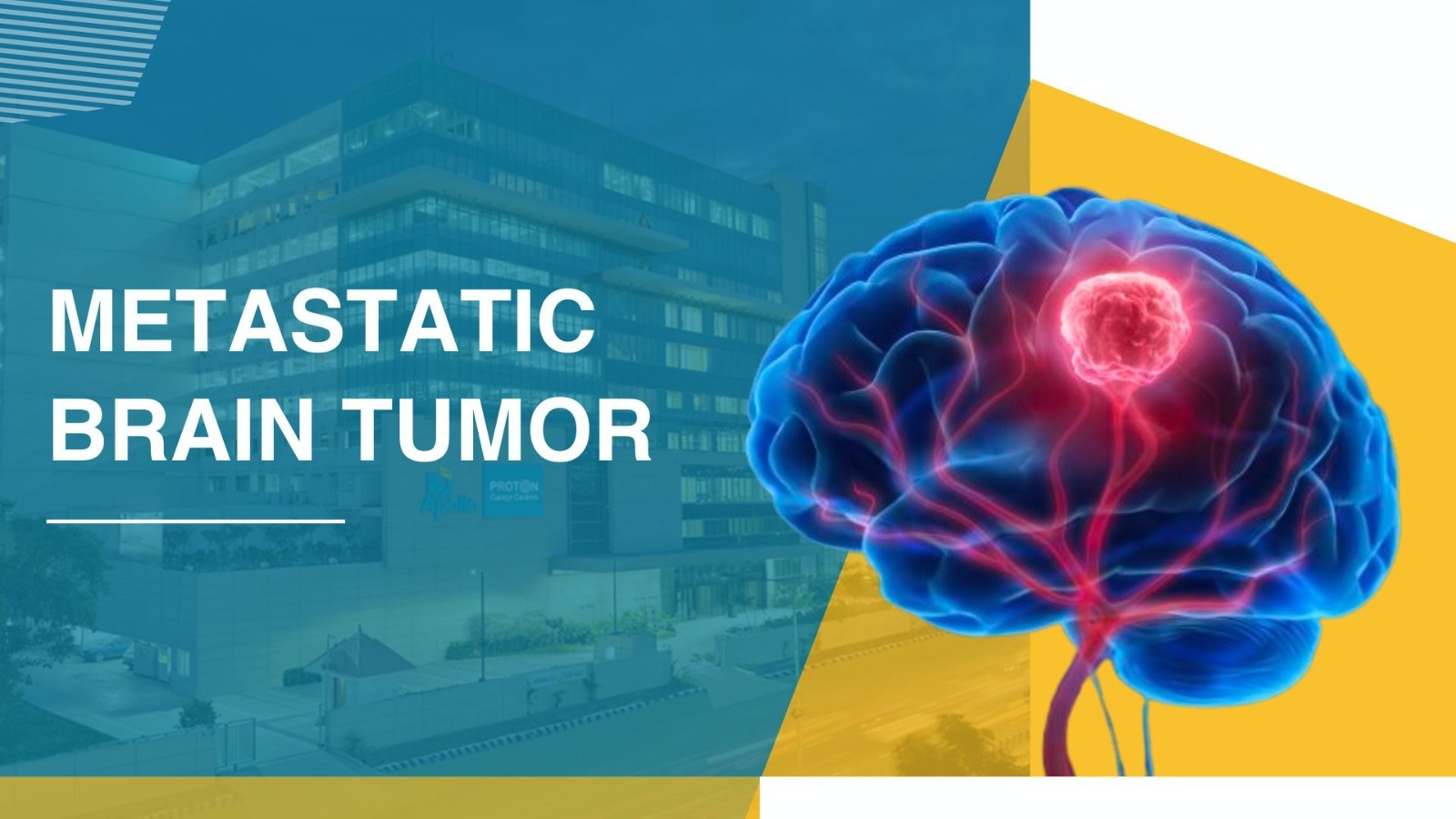What is metastatic brain tumors?
Metastatic brain tumours, also known as secondary brain tumours, are cancerous tumours that begin in another part of the body and spread to the brain via the bloodstream or lymphatic system. They differ from primary brain tumours, which develop within the brain itself.
Metastatic brain tumours are relatively common and can affect people of any age, though they are more likely to affect older people and those with a cancer history. They can be caused by a variety of cancers, including breast, lung, colon, and kidney cancer, to name a few.
Depending on the location and size of the tumour, symptoms of metastatic brain tumours may include headaches, seizures, changes in speech or vision, difficulty with balance and coordination, and memory and cognition problems.
Depending on the circumstances, treatment for metastatic brain tumours typically consists of a combination of chemotherapy, radiation therapy, and surgery. The prognosis for metastatic brain tumours varies depending on the type of cancer, the stage of the cancer, and the patient's overall health.
Why is it difficult to treat metastatic brain tumors?
Metastatic brain tumours can be difficult to treat for a variety of reasons, including:
- Limited access: Because the brain is a delicate organ protected by the skull and the blood-brain barrier, doctors may struggle to access and treat tumours. This can make surgery or administering chemotherapy and radiation to the brain difficult.
- Treatment resistance: Some cancer cells may be resistant to chemotherapy and radiation, making it difficult to treat metastatic brain tumours effectively.
- Treatment side effects: Treatment for metastatic brain tumours, such as chemotherapy and radiation, can cause severe and debilitating side effects such as fatigue, nausea, and cognitive problems.
- Tumor location: The location of the tumour can also affect its ability to be treated. Tumors in brain areas that control critical functions like speech or movement may be more difficult to treat without causing significant side effects.
- Advanced cancer stage: If the cancer has spread to the brain at a later stage, treatment may be more difficult and the prognosis may be worse.
Overall, the treatment of metastatic brain tumours can be complex and difficult, and the outcome is dependent on a variety of factors, including the type of cancer, the stage of the cancer, and the patient's overall health.
Best treatment for metastatic brain tumors
The type of cancer that has spread to the brain, as well as the location and size of the tumours, all influence treatment for metastatic brain tumours, also known as secondary brain tumours. The primary goal of treatment is to slow tumour growth and alleviate symptoms. The following are some common treatments for metastatic brain tumours:
- Surgery: If the tumour is small and located in a safe area of the brain, surgery may be an option.
- Radiation therapy: This method of killing cancer cells involves the use of high-energy beams. It can be administered alone or in conjunction with chemotherapy.
- Chemotherapy: This is when drugs are used to kill cancer cells. It can be administered orally or intravenously.
- Targeted therapy entails using drugs to target specific genetic changes in cancer cells.
- Immunotherapy: This is the use of medications to boost the body's immune system in order to combat cancer cells.
To determine the best treatment plan, it is critical to collaborate with a team of healthcare professionals, including oncologists, neurosurgeons, and radiation oncologists. It is also critical to consider potential treatment side effects and discuss them with your healthcare team.
How does immunotherapy help to treat metastatic brain tumors?
Immunotherapy is a treatment method that employs the body's own immune system to combat cancer cells. It stimulates the immune system, causing it to recognise and attack cancer cells. Immunotherapy comes in a variety of forms, including:
- Monoclonal antibodies: These are proteins that are specifically designed to bind to proteins on cancer cells. They can assist the immune system in identifying and attacking cancer cells.
- T-cell therapy: T cells (a type of immune cell) are extracted from the patient's blood, modified to recognise and attack cancer cells, and then reintroduced into the patient's body.
- Checkpoint inhibitors: These are drugs that prevent cancer cells from evading the immune system. Checkpoint inhibitors enable the immune system to recognise and attack cancer cells by blocking these proteins.
Immunotherapy has shown promise in treating a variety of cancers, including metastatic brain tumours. However, it is still regarded as an experimental treatment for brain tumours, and more research is required to determine its efficacy and optimal use in this setting. To determine if immunotherapy is an appropriate treatment option for you, you should discuss the potential risks and benefits with your healthcare team.
How does targeted therapy help to treat metastatic brain tumors?
Cancer treatment that targets specific molecules or pathways involved in the growth and spread of cancer cells is known as targeted therapy. In the case of metastatic brain tumours, targeted therapies may be used to either inhibit or directly kill cancer cells.
Bevacizumab, a monoclonal antibody that targets a protein called vascular endothelial growth factor, is one example of a targeted therapy used to treat metastatic brain tumours (VEGF). VEGF is involved in the formation of new blood vessels, and high levels of VEGF are frequently found in cancer cells. Bevacizumab, by inhibiting VEGF, can slow the growth of cancer cells and prevent them from spreading to other parts of the body.
Tyrosine kinase inhibitors, which target enzymes involved in cancer cell growth and survival, and immune checkpoint inhibitors, which help the immune system recognise and attack cancer cells, are two other targeted therapies that may be used to treat metastatic brain tumours.
To achieve the best possible outcome, targeted therapies are frequently used in conjunction with other cancer treatments such as chemotherapy, radiation therapy, and surgery. The specific treatment approach will be determined by the type and stage of the cancer, as well as the patient's overall health.
Why is proton beam therapy effective for treating metastatic brain tumors?
Proton beam therapy is a type of radiation therapy in which a beam of positively charged protons is used to deliver high doses of radiation to cancer cells. It is thought to be an effective treatment for metastatic brain tumours because it can deliver high doses of radiation to the tumour while exposing as little healthy tissue as possible.
One of the primary benefits of proton beam therapy is that it allows for more precise targeting of cancer cells, potentially lowering the risk of side effects and complications associated with radiation therapy. Furthermore, proton beam therapy can be tailored to deliver different doses of radiation to different parts of the tumour, thereby sparing healthy tissue and lowering the risk of long-term side effects.
Proton beam therapy is typically used to treat tumours in sensitive areas of the body, such as the brain, head and neck, and spinal cord, where exposure to healthy tissue must be minimised. To achieve the best possible outcome, it is frequently used in conjunction with other cancer treatments such as chemotherapy and surgery.
Surgery for treating metastatic brain tumors
Metastatic brain tumours, also known as secondary brain tumours, are cancerous tumours that have spread to the brain from another part of the body's primary cancer site. They are the most common type of adult brain tumour.
For the treatment of metastatic brain tumours, there are several surgical options available, including:
- Craniotomy: This is a surgical procedure that involves removing a section of the skull to gain access to the brain. This is usually done to remove the tumour or to obtain a biopsy (tumour tissue sample) for further testing.
- Stereotactic radiosurgery: This is a non-invasive surgical procedure that destroys tumour cells using high-energy X-rays or other types of radiation. It is typically used to treat small tumours or tumours in difficult-to-reach areas of the brain.
- Cyberknife: A type of radiosurgery in which a robotic arm is used to deliver high-energy X-rays to the tumour. It is extremely accurate and can be used to treat tumours in hard-to-reach areas of the brain.
- Gamma knife: A type of radiosurgery that employs gamma radiation to treat brain tumours. It is typically used to treat small tumours or tumours in difficult-to-reach areas of the brain.
Treatment for metastatic brain tumours may include chemotherapy, targeted therapy, and/or radiation therapy in addition to surgery. The specific treatment plan will be determined by the type and stage of the cancer, as well as the patient's overall health.
Chemotherapy for treating metastatic brain tumors
Chemotherapy is a type of treatment in which drugs are used to kill cancer cells. It is frequently used to treat metastatic brain tumours, which are tumours that have spread from another part of the body to the brain.
There are several chemotherapy drugs that can be used to treat metastatic brain tumours, and the specific drug or combination of drugs used will be determined by the type and stage of the tumour, as well as the patient's overall health. Chemotherapy can be administered as a pill, an injection, or through a vein (intravenously).
Chemotherapy is typically administered in cycles, with each cycle consisting of a treatment period followed by a rest period to allow the body to recover. The treatment plan will differ depending on the drug or drugs used and the patient's condition.
Chemotherapy has the potential to be an effective treatment for metastatic brain tumours, but it is not without risks and side effects. Nausea, vomiting, hair loss, fatigue, and an increased risk of infection are all common side effects of chemotherapy. Serious side effects are possible, but they are uncommon.
Before beginning treatment, it is critical to discuss the potential risks and benefits of chemotherapy with your healthcare team. They can advise you on what to expect and how to deal with any side effects that may arise.
Radiation for treating metastatic brain tumors
Radiation therapy is a type of treatment that kills cancer cells by using high-energy beams such as X-rays or protons. It is frequently used to treat metastatic brain tumours, which are tumours that have spread from another part of the body to the brain.
External beam radiation and stereotactic radiosurgery are two types of radiation therapy that may be used to treat metastatic brain tumours. The type of radiation therapy used will be determined by the location and size of the tumour, as well as the patient's overall health.
External beam radiation is delivered from a machine outside the body in daily sessions over a period of several weeks. Stereotactic radiosurgery is a type of radiation that is delivered in a single or limited number of sessions.
Although radiation therapy is an effective treatment for metastatic brain tumours, it is not without risks and side effects. Radiation therapy commonly causes fatigue, skin irritation, and hair loss in the treated area. Serious side effects are possible, but they are uncommon.
Before beginning treatment, it is critical to discuss the potential risks and benefits of radiation therapy with your healthcare team. They can advise you on what to expect and how to deal with any side effects that may arise.
Radiation versus proton beam therapy for treating metastatic brain tumors
Radiation therapy and proton beam therapy are both types of cancer treatment that employ high-energy beams to kill cancer cells. Both may be used to treat metastatic brain tumours, which are tumours that have spread from another part of the body to the brain.
Radiation therapy destroys cancer cells by using X-rays or other forms of ionising radiation. It can be administered via external beam radiation, which is delivered from a machine outside the body, or via stereotactic radiosurgery, which is a highly focused form of radiation administered in a single or limited number of sessions.
Proton beam therapy is a type of radiation therapy in which high doses of radiation are delivered to a specific area of the body using protons, which are subatomic particles. It is usually given in daily sessions over several weeks.
Both radiation therapy and proton beam therapy can be effective treatments for metastatic brain tumours, but there are some distinctions between them. Proton beam therapy may be more precise than traditional radiation therapy because it can more precisely target the tumour while exposing less healthy tissue. As a result, there may be fewer side effects and a lower risk of long-term complications. Proton beam therapy, on the other hand, is not widely available and may not be an option for all patients.
Before beginning treatment, it is critical to discuss the potential risks and benefits of both radiation therapy and proton beam therapy with your healthcare team. They can help you understand which option is best for your specific situation and make an informed decision about your care.
To know more about Proton Beam Therapy and Apollo Proton Cancer Centre, write to us at apollocancercentres@apollohospitals.com or call us on 1800 203 1066 / +91 40 48964515.

Copyright © 2023 Apollo Proton Cancer Centre. All Rights Reserved





